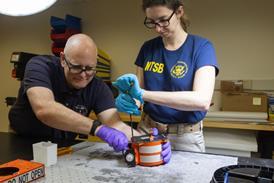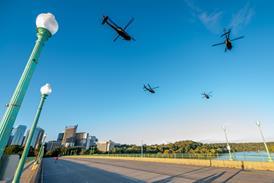
Paul Lewis/MITIKA
Japanese engineers have long displayed a distinctive flair for futuristic transportation thinking. While there may be a tendency in the West to confine many such notions to the realms of science fiction, it is worth remembering that Japan is the home of the Shinkansen "bullet train" and the ultra high speed ship. The concept of a supersonic transport (SST) aircraft has similarly caught the Japanese imagination and, while the USA and Europe continue to dither, Tokyo is investing hard yen to turn that dream into reality.
SST-related research now constitutes the single largest line item in the Ministry of International Trade and Industry's (MITI) aerospace budget. Its recently approved spending for fiscal year 1998/9 allows for ´4.03 billion ($29 million) in SST funding, accounting for almost 45% of MITI's total aerospace allocation. The vast bulk is for the Hypersonic Transport Propulsion System (HYPR).
Less publicised is the sizeable contribution also being made by the separately funded National Aerospace Laboratory (NAL). The organisation, at Mitaka, near Tokyo, was founded in 1955 by the prime minister's office and reports directly to the Science and Technology Agency. Past research activities include the LE7 rocket, the ASKA short take-off and landing experimental aircraft and the unmanned winged H-II Orbiting Plane.
NAL, in parallel with MITI and private industry, is increasingly channelling the efforts of its 427-strong staff into the field of SST research and has set up an advanced aircraft project office. There has also been a comparable hike in funding. The SST now commands the largest single slice of NAL's ´9.21 billion research budget for FY1998/9, accounting for 21% compared to 17% the year before.
The new project office's supervising researcher, Kimio Sakata, identifies three key areas in which Japan could potentially be a leading SST team player. They are computational fluid dynamics (CFD) design, material and structures and propulsion systems. This is where NAL, along with its MITI-funded industrial team of Fuji, Ishikawajima-Harima (IHI), Kawasaki, Mitsubishi and Nissan, is concentrating resources.
NUMERICAL WINDTUNNEL
NAL has developed the use of CFD by amassing about 160 supercomputers to form a numerical windtunnel, used to simulate and visualise airflow across an airframe or through a turbofan. "This is the fourth or fifth largest system in the world in terms of performance-it can be used to show pressure distribution, turbulence behaviour or turbine flow," says Masaaki Murata, NAL control systems division director.
NAL has incorporated the use of CFD as part of its enhanced "inverse method" design capability. In simple terms, a performance target is set, such as pressure distribution, and entered into a computer, which performs calculations to produce the optimum aerodynamic shape that comes closest to matching the prediction. The inverse and optimisation approach offers the advantage of better design precision at lower cost than that of the conventional method.
To verify and further develop its CFD-based design technology, NAL has embarked on an eight-year experimental aircraft programme costing ´20 billion. The first phase involves producing a 1:10-scale unpowered SST aircraft, built of alloy, to make a first flight in 2002.
The 2,000kg (4,400lb) demonstrator, designed using the inverse method, features a 4.72m-span cranked arrow wing with warp effect for low induced drag and laminar flow for reduced friction drag. NAL, using the "area rule", has designed an 11.5m-long slender fuselage body for minimal shockwave effect.
"The aircraft will be launched from the ground using a strap-on rocket. After reaching Mach 2 and an altitude of about 15,000m [49,200ft], it will separate from the rocket and fly as a supersonic glider," says Sakata.
A total of four flights is planned from the Woomera test site in Australia, each lasting about 200-250s and extending over a range of 100km (55nm). One of two onboard computers will store and downlink aerodynamic data such as angle of attack and Reynolds-sweep readings in different air densities. The airframe will use a self-deployed parachute system for recovery.
Phase two of the experimental aircraft programme will entail flying a similarly sized demonstrator, but this time powered by two 8kN (1,800lb)-thrust Teledyne drone turbojet engines. The second demonstrator will be used to verify CFD software for a high lift/drag ratio design, as well to test the applications of composite materials and the integration of underwing engine intakes, nacelle and nozzles.
"We think that the engine/airframe integration on a future SST will be one of the most difficult and delicate aerodynamic design tasks in terms of reducing drag generated by interference between wing and nacelle," explains Sakata. Using CFD-based design to optimise the shape and position of the nacelle diverter, NAL hopes to minimise boundary layer separation drag.
NAL is planning to conduct "more than 10 flights", each of about 10min, starting in around 2003/4. The vehicle will again be launched by a Nissan/Institute of Space and Aeronautical Sciences single-stage sounding rocket, with a parachute for recovery. The flight test programme will include angle of attack, variable loadings and low sonic boom ground effects.
The majority of Japanese Government SST funding has so far been spent on experimental propulsion work, including ´28 billion since 1989 to support the HYPR. The programme, overseen by the New Energy and Industrial Technology Department Organisation, has involved the participation of IHI, Kawasaki and Mitsubishi, along with General Electric, Rolls-Royce, Snecma and United Technologies.
COMBINED-CYCLE TESTING
The HYPR is is designed to demonstrate the concept of a combined-cycle engine, using a conventional turbojet to provide propulsion up to Mach 3 before switching to an integrated ramjet for sustained speeds from M3-5. Using a 1:3-scale engine, GE has successfully completed altitude testing of the turbojet element. Combined-cycle testing up to the M3 switching point is to be complete in 1999.
NAL's responsibilities are confined to the CFD design of the engine's air intake, ram combustor, nozzle and variable-cycle controls for high ratio/low noise take-off and low ratio/high speed flight.Separate testing of a model ramjet is under way at NAL's Kakuda site, but where the HYPR goes from here is unclear. "This programme is aimed at accumulating hypersonic technology, but there is no comparable fuselage study under way," concedes Sakata.
Attention appears to be turning instead to producing a more modest M2.2-2.4 supersonic demonstrator engine by 2003, with the emphasis on keeping noise at existing levels and cutting ozone-destroying nitrous-oxide emissions to one-seventh of those of current emissions. MITI is seeking ´15 billion in funding for the five-year programme, for a start to be made in the next fiscal year - 1999/2000.
This class of engine also provides a more realistic reflection of the types of material available for constructing an SST. Sakata estimates that speeds above M2.5 will require nose and leading-edge composite structures to be resistant to far higher temperatures than the 180-200¼C maximum now envisaged.
Particular attention will need to paid to the material design of engine inlets on the next generation of SST, which will require a much greater level of heat resistance than that of the Aerospatiale/BAC Concorde's R-R Olympus 593 turbojet. "The inlet temperature for the Olympus is only around 1,200°C, compared to a projected 1,600°C for any new engine. The difference is very large in terms of propulsion technology, material and cooling," says Sakata.
Japanese payload range goals for the next generation SST closely mirror those of European and US manufacturers, notably for a 300-seat capacity and cruise range of around 11,000km. Central to achieving this performance target is the use of new lightweight composite structures that could conceivably comprise up to 60% of the airframe content.
ADVANCED MATERIAL FUNDING
This year, MITI has committed over ´900 million towards further development of new advanced materials such as titanium and carbonfibre composites and leading Japanese carbonfibre composites and resin manufacturers, such as Toray and Mitsui Toatsu Chemicals, are now beginning to collaborate with the aerospace industry on new materials. At the same time, Japan's three principal airframe manufacturers, Fuji, Kawasaki and Mitsubishi, are working to further composite design applications and assembly techniques.
Large as the combined MITI and NAL sums are, they represent only a fraction of the estimated $16-20 billion needed to develop a successor to the Concorde and Japan's investment is geared more towards gaining admission to a future international collaborative effort. "An SST programme will be costly and international co-operation will be the primary role of Japan, but we have to provide some technology to get a seat at the round table," concludes Sakata.
Source: Flight International























